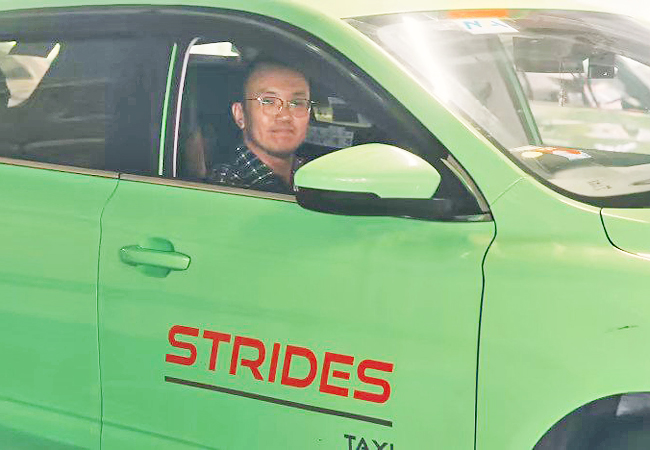CNA – Whenever older passengers remark that they see fewer taxi drivers these days, Delon Tuan responds with “a very realistic comment” that he believes some of them “might not stomach well”.
“I just say: ‘But nobody aspires for their children to be taxi drivers.’ Then some of them will keep quiet,” the taxi driver with ComfortDelGro told CNA.
“(Taxi driving is) one of those things that… you never realise how important it is in the cog of how society works and how things move along. People might make comments like, why would you aspire to be a taxi driver?
“But my question is, if there are no taxis around Singapore, do you think you can get things done?”
Any stigma around being a taxi driver doesn’t faze Tuan, who considers himself “very open to trying new things”. But he was quick to add that he isn’t a “nine-to-five kind of person”.
Wanting to “try something different”, he stumbled into the taxi industry almost a year ago following a career as a professional chef, which took him from the kitchens of restaurants in Marina Bay Sands to a two-star Michelin restaurant in Finland.
The 38-year-old is not the only millennial who gamely joined a sunset industry – or who has passengers point out his youth.



BUCKING AGE, GENDER STEREOTYPES
While some may argue the taxi industry began its decline with the entrance of ride-hailing platforms Uber and Grab a decade ago, the COVID-19 pandemic resulted in an obvious industry-wide shortage of drivers.
But the dearth of drivers was steeper among cabbies, with about 9,000 fewer active drivers compared to pre-pandemic.
Many drivers who left the industry were those driving night or weekend shifts, said Senior Minister of State for Transport Amy Khor in Parliament in March.
The taxi industry has also not been traditionally known to attract the younger generation. In 2019, then Transport Minister Khaw Boon Wan said in a written parliamentary reply that 7.6 per cent of taxi driver’s vocational licence (TDVL) holders were aged 30 to 39 as of February that year.
In comparison, 33.4 per cent of TDVL holders were aged 60 to 74.
On the other hand, 44.4 per cent of private hire car driver’s vocational licence (PDVL) holders were aged 30 to 39, while only 8.5 per cent were aged 60 to 79.
Samantha Noh is used to getting stares when she visits the workshop. Passengers are also surprised when they notice the petite 38-year-old behind the wheel of their ride, as a young female taxi driver is “not a common sight”.
“They will say, ‘Oh miss, you’re young, why do you start driving taxi?’ These are the questions I get which means they are taking notice and it’s making some change somewhere, a step at a time. It’s a very good sign for me,” said the taxi driver who’s been with ComfortDelGro for just over half a year. The stereotype is that a taxi driver is “definitely an uncle”, but Noh has started to notice more drivers around her age “trying to prove that we can make a change” in the male-dominated industry.
“The industry needs to start getting younger and livelier. We need to let people know that, yes, this is an honest living.”
Like Tuan, the mother-of-two wanted “something else to challenge” herself after six years as an interior designer.
Her family thought she would become a private-hire driver as “everybody thought it was more of a younger generation thing”, but her cousin who was just a year older and also getting his taxi licence then convinced her to give the industry a shot.
The skills Noh picked up as an interior designer, from the long hours spent managing projects to dealing with all sorts of clients, ended up coming in handy as a taxi driver.
“You see a lot of tougher customers back then during renovation, tough contractors too.
Nothing can be as tough as what you’ve done before. Things will always seem to be better because you’ve already done what you think is worse,” she added.
“That helps to balance out (the challenges), if things are not smooth that day.”
IMPATIENT MOTORISTS, DIFFICULTY FINDING LOCATIONS
What does a day that’s “not smooth” entail? Tuan told CNA he did not expect to be on the receiving end of verbal abuse from some passengers.
“An example would be if a customer makes a wrong booking and just vents it out on me. I didn’t do anything wrong, like what can I do right? I just didn’t expect that kind of treatment,” he recalled.
The behaviour of other motorists also leaves much to be desired, noted another taxi driver.
A driver with Strides, Lawrence Li joined the industry around August last year after being solely a private-hire driver for eight years.
The 37-year-old faced “discrimination” from motorists on the road, which he hadn’t experienced as a private-hire driver.
“During my first few months of driving, I received a lot of honks. Even though it might be a trivial matter, they (honk at) you over nothing and they won’t give way to you,” he said, adding that older taxi drivers told him such behaviour has been around for “a long time”.
“But Singaporean drivers are just impatient in general. You can’t blame them… You just have to swallow it. You can’t do anything much.”
Then there is the juggling act of having to be an encyclopaedia, street directory and tour guide at once, two drivers shared.
“I think the disadvantage (of being young) is more about the landmarks. When I pick up passengers and they use certain phrases, or even with tourists who came to Singapore before and now they’re returning, they say they’d like to go to this place, that place. And I’m like, where’s that?” said Tuan.
“Or maybe the older generation will (talk to you about) a location… that is a place of the past. People have an attachment to it. But to me, I never experienced it (that way) so I don’t know where it is.”
Even with existing buildings, it can be challenging to keep up with hotel names or where a taxi stand and drop-off point is at a new location, added Noh who “did not expect” so much knowledge and skills involved in driving a taxi.
She had assumed driving a taxi “should be quite easy”, simply ferrying a passenger from point A to B.
“For new locations, where are the drop-offs? When we drive (a) private-hire (car), we find car parks, but when we drive taxis, we have to find taxi stands to drop off… There are thousands of taxi stands and drop-off points we need to learn.”
With tourists, Noh also hopes to welcome them to Singapore with tips on where they can go for good food and fun. But some end up asking for specific information, such as the opening hours of an attraction.
“You don’t expect them to ask, but when they ask, you’re like, okay, maybe give me a second,” she said laughing.
INTERACTING WITH PASSENGERS, TAXI COMMUNITY
Despite the challenges, the satisfaction of engaging in a meaningful encounters drives them.
Tuan, who also runs a business in Hong Kong, considers himself outgoing and enjoys interacting with passengers.
He has even become a “regular driver” for some of his passengers-turned-friends. Similarly, Noh hopes her positivity rubs off on every passenger who hops in her taxi.
“When I see somebody not having a good day, I say hi, ask how their day is. Sometimes when they just talk about their job, they will release their energy and stress. It’s like a short therapy session,” she said.
“If they don’t want to talk, drivers can sense it, but even a good greeting for the day makes a difference.”
Occasionally, when she returns home after a long day, she even gets to tell her eight-year-old daughter a bedtime story about a passenger she met that day.
She once told her daughter about a “very brave” wheelchair user she assisted. After an entire year of not leaving the house, the passenger plucked up her courage to visit a mall by herself that day. The incident left a mark on Noh, who remembered it as a “very happy day”.
Another time, she told her daughter about a “very interesting” couple from China who flew to Singapore just to give a letter to the Prime Minister.
She sought the advice of other taxi drivers before taking the grateful couple to the Treasury to deliver their letter.
Noh has found this community of taxi drivers to be a crucial support system that extends beyond helping with directions and locations.
“Everybody thinks taxi driving is just driving alone in the car, which is a very lonely job, if you think that way. Having a group of drivers who are the same is like having colleagues in the office. That support group works very well, and it improves your mental health as well,” she said.
REAPING THE REWARDS
But getting the most out of the job, whether it’s pay or purpose, ultimately boils down to the individual’s mindset, Tuan believes.
“Obviously (the job) gives you the flexibility to, say, go to the gym and manage your wellness. So there has to be a lot of discipline because it’s your income. If you don’t drive, you don’t earn. It’s about managing yourself,” he said.
“If you put in the effort, you will get the reward. Maybe not as much some days, but it will still be more or less substantial depending on how you drive.”
There are also “strategies” to navigate the streets more effectively to increase earnings, he explained, such as waiting at the Indoor Stadium if a concert is going on. Taxi drivers can also wait at taxi stands when they’re not out and about.
With his daily earnings largely depending on where he drives, Tuan has also grown more aware of what’s happening in Singapore.
“In the past, you might not have understood why the weather is important, or how certain things like F1 or airport closure affect you. But now, what happens on this island is very important.
“You suddenly have a whole grasp of the general situation (in the country), like work-from-home,” he explained.
Before, he liked the idea of work-from-home. But as a taxi driver, he realised that meant fewer passengers to pick up.
Asked whether he sees taxi driving as a long-term plan, Tuan simply highlighted the stability of the job.
“This is not a gig economy (job). This is a career… And the Public Transport Council actually protects taxi drivers. It’s not like today the taxi fare is SGD3, tomorrow it’s going to be SGD6. It’s a stable job. I think that’s the most important thing.”
In the short term at least, he has made it a personal mission to memorise every corner of Ang Mo Kio, where he lives, without using any maps.









